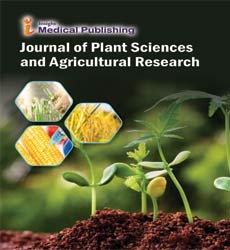The Rhizosphere Microbiome: Bacterial Allies Beneath the Surface
Ylenia Vittozzi*
Department of Botany and Plant Physiology, Czech University of Life Sciences Prague, Prague, Czech Republic
- *Corresponding Author:
- Ylenia Vittozzi
Department of Botany and Plant Physiology, Czech University of Life Sciences Prague, Prague,
Czech Republic,
E-mail: Vittozzi_y@cufsa.cz
Received date: May 27, 2024, Manuscript No. IPJPSAR-24-19083; Editor assigned date: May 29, 2024, PreQC No. IPJPSAR-24-19083 (PQ); Reviewed date: June 12, 2024, QC No. IPJPSAR-24-19083; Revised date: June 19, 2024, Manuscript No. IPJPSAR-24-19083 (R); Published date: June 26, 2024, DOI: 10.36648/ipjpsar.8.2.145
Citation: Vittozzi Y (2024) The Rhizosphere Microbiome: Bacterial Allies Beneath the Surface. J Plant Sci Agri Res Vol.8 No.2: 145.
Description
In the lush green expanse of our planet's flora lies an unseen universe teeming with life and complexity: The realm of plant microbiota. Often overlooked by the naked eye, these microscopic organisms play a vital role in the health and resilience of plants, shaping ecosystems and influencing the very fabric of life on Earth. At the heart of plant microbiota are bacteria, fungi, archaea and viruses, each contributing uniquely to the well-being of their botanical hosts. These microorganisms can be found residing both on the surfaces of plants, known as the phyllosphere and within the soil surrounding their roots, known as the rhizosphere. The intricate interplay between plants and their microbial inhabitants forms a symbiotic relationship that has evolved over millions of years, resulting in mutual benefits for both parties. One of the most well-known associations within plant microbiota is that between plants and mycorrhizal fungi. Mycorrhizae form a symbiotic relationship with the roots of plants, extending their reach into the soil and enhancing the plant's ability to absorb water and nutrients, particularly phosphorus and nitrogen. In return, the fungi receive vital carbohydrates produced by the plant through photosynthesis. This exchange not only benefits individual plants but also contributes to the overall health and productivity of entire ecosystems.
Diversity of microorganisms
Beyond mycorrhizae, a diverse array of bacteria populates the rhizosphere, forming intricate communities known as the rhizosphere microbiome. These bacteria play a vital role in nutrient cycling, nitrogen fixation, and disease suppression, among other functions. For instance, certain bacteria can solubilize phosphorus, making it more available to plants, while others produce antibiotics that protect their plant hosts from pathogenic invaders. In addition to bacteria and fungi, viruses are also integral members of the plant microbiota community. While viruses are often associated with disease, they can also have beneficial effects on plants. For example, some viruses infect pathogenic bacteria, helping to control their populations and prevent the spread of disease. Furthermore, recent research has revealed that certain viruses can induce systemic resistance in plants, priming them to defend against future infections by pathogens. The phyllosphere, or the above-ground parts of plants, also harbors a rich diversity of microorganisms. The leaves of plants, in particular, provide a habitat for bacteria, fungi and even algae. These microorganisms can influence various aspects of plant health, including nutrient uptake, water retention and resistance to pests and diseases. Furthermore, they can play a role in shaping the aroma and flavor profiles of certain plants, making them essential contributors to agricultural systems and culinary traditions. Understanding the dynamics of plant microbiota is not only crucial for agriculture and ecosystem management but also holds promise for sustainable solutions to global challenges such as food security and climate change. By harnessing the power of beneficial microorganisms, scientists are exploring innovative approaches to enhance crop yields, reduce the need for chemical fertilizers and pesticides and mitigate the effects of environmental stressors on plant health. One such approach is the development of microbial inoculants, which consist of beneficial microorganisms that are applied to seeds or soil to promote plant growth and health. These inoculants can include a range of microorganisms, from nitrogen-fixing bacteria to mycorrhizal fungi, to specific crops and environmental conditions. By harnessing the natural symbiotic relationships that exist within plant microbiota, microbial inoculants offer a sustainable alternative to conventional agricultural practices, reducing reliance on synthetic inputs and minimizing environmental impact. Furthermore, advances in DNA sequencing and bioinformatics have revolutionized our ability to study plant microbiota, allowing researchers to unravel the complex interactions between plants and their microbial partners with unprecedented precision. By leveraging these tools, scientists can identify key microbial taxa associated with plant health and develop strategies to manipulate microbiota composition for desired outcomes. In conclusion, the world of plant microbiota is a and intricate ecosystem that plays a fundamental role in the health and functioning of terrestrial ecosystems. From mycorrhizal fungi to rhizosphere bacteria to phyllosphere microorganisms, the diverse array of microorganisms associated with plants form complex networks of interactions that shape the very foundation of life on Earth. By unraveling the mysteries of plant microbiota and harnessing their potential, we can the way for more sustainable and resilient agricultural systems that nourish both people and the planet.
Open Access Journals
- Aquaculture & Veterinary Science
- Chemistry & Chemical Sciences
- Clinical Sciences
- Engineering
- General Science
- Genetics & Molecular Biology
- Health Care & Nursing
- Immunology & Microbiology
- Materials Science
- Mathematics & Physics
- Medical Sciences
- Neurology & Psychiatry
- Oncology & Cancer Science
- Pharmaceutical Sciences
